The 2011 MacBook Air (11 & 13-inch): Thoroughly Reviewed
by Anand Lal Shimpi on July 28, 2011 3:25 AM EST- Posted in
- Apple
- Mac
- Intel
- Sandy Bridge
- MacBook Air
- Laptops
The Display: Better than Most, Not as Good as the Pro
When I reviewed last year's MacBook Airs I came away impressed by the displays. The MacBook Air, particularly the 11-inch, was a netbook alternative for many. You got much better performance (at a higher cost of course) than any netbook but in a great form factor. Compared to those ultra cheap machines, the 11 and 13-inch MacBook Air from 2010 had great displays.
This year things are a bit different. Equipped with Sandy Bridge CPUs these new MacBook Airs can still be ultraportable competitors, but for many the new systems are faster than their current notebooks. If you bought a MacBook Pro in 2008, even the 11-inch MacBook Air is faster with its 1.6GHz CPU. Last year's models may have been great ultraportables, but this year's Air lineup are great notebooks. As a result we have to compare their displays to both the low end of the PC market as well as the high end of the Mac market.
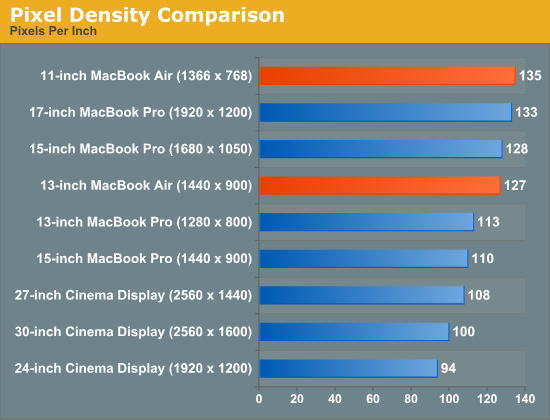
First the bad news. The 13-inch MacBook Air Apple sent me for review has a noticeably dimmer panel than the one I reviewed last year. The 2010 model I reviewed was 21% brighter at its highest setting. This will vary depending on the panel you get (and the panel you had) but with the wrong combination you'll be left with a noticeably dimmer display. That being said, even at 354 nits the 13-inch MacBook Air is far brighter than most PC notebooks. Not to mention the fact that 354 nits is often a bit too bright, I usually find happiness at around 200 - 250 nits.
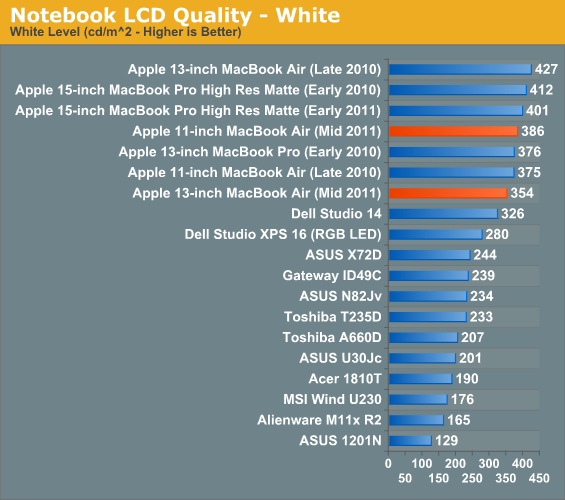
The 11-inch MacBook Air on the other hand was slightly brighter than the one I reviewed last year. Don't get too excited though, my personal 11-inch MacBook Air puts out 408 nits at max brightness - 6% more than the new 2011. It's going to be luck of the draw here but don't expect these new panels to be significantly brighter than last year's. If anything, there's a good chance that your new MacBook Air will be dimmer than your old one (if you're a yearly upgrader that is).
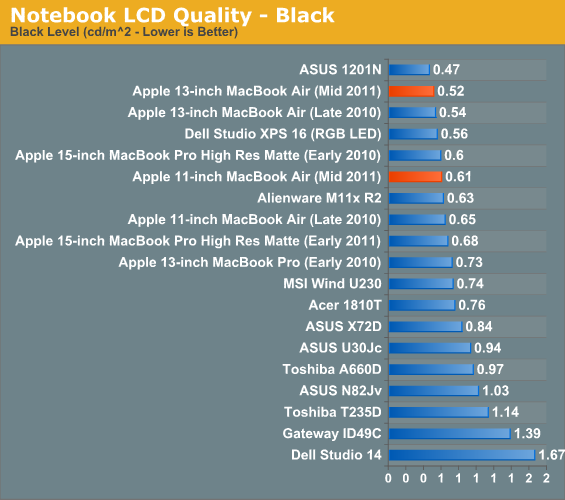
Black levels are slightly better on the 13, but not enough to overcome the drop in brightness. Contrast is down as a result on the 13, but up on the 11. Both are still in a league of their own among notebooks in this price range. As far as brightness, black levels and contrast are concerned, the MacBook Air is pretty much on par with the MacBook Pro.
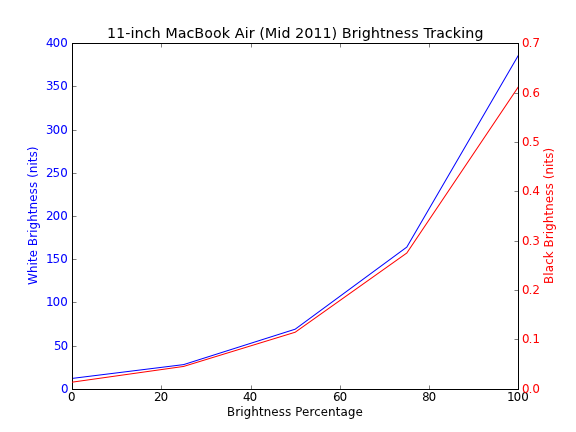
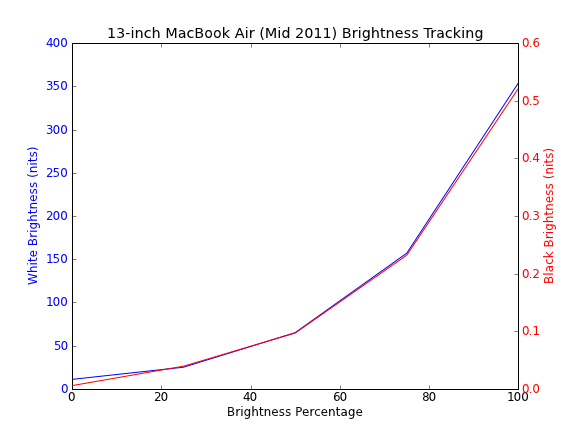
Where the Air stops filling its bigger brother's shoes is in viewing angles and color gamut. The MacBook Air uses a lower quality TN panel than what's in the MacBook Pro, causing viewing angles to suffer.
Viewed straight on the Air's panel looks great. It's bright and has a reasonable ~6800K white point calibrated from the factory; uncalibrated deltaE is around 8.58 though. Viewed from above colors begin to wash out:
Viewed from below there's some color shift and the screen gets much darker.
Left/right viewing angles are pretty good though, colors don't change you just lose a bit of brightness.
The issue with poor vertical viewing angles is particularly a problem on these ultra portables since there's a good chance you'll have to tilt the screen back further than normal depending on your desk/seating/lap position. If you're coming from an older MacBook Pro you'll likely be disappointed by viewing angles on the MacBook Air.
Compared to the old MacBook the Air has a much better display, it's only compared to the Pro that you do sacrifice a bit in quality.
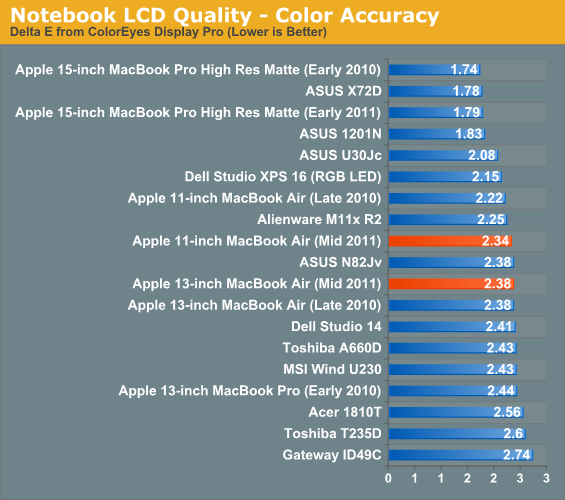
Calibrated color accuracy is pretty good on the Air, although not quite as good as the MacBook Pro. Color Gamut also hasn't improved since last year's Air:
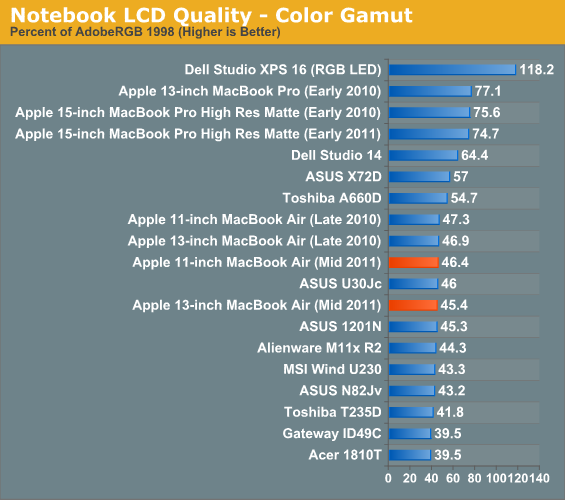
Apple calibrates white point on all of its Macs before they leave the factory. Both the 11 and 13-inch Macbook Air have a white point around 6800K that tracks consistently across all brightness settings:

There are at least two different panel vendors in the new Airs, both of my Airs used panels from the same company though:
LTH133BT01A03
LTH116AT01A04
It's quite possible that users with a different panel could have a different experience than what I've published here.


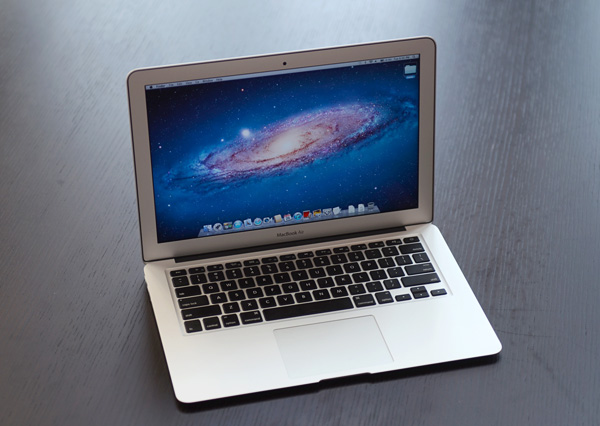
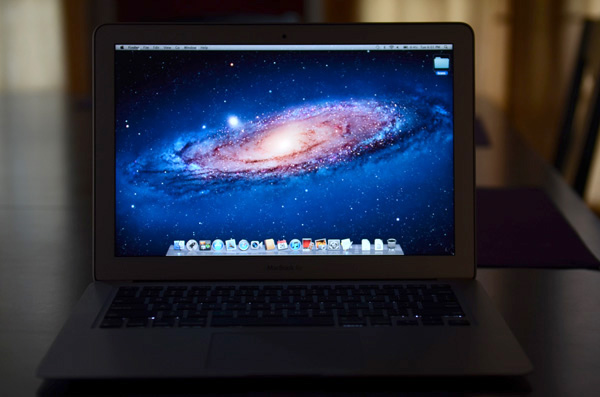
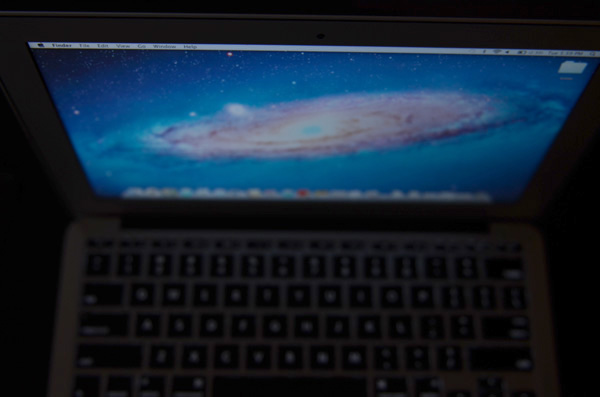
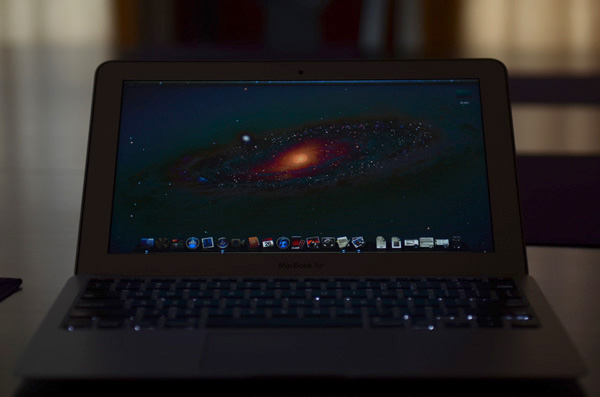
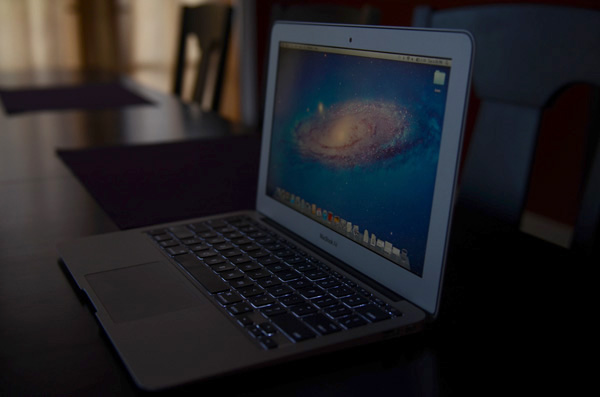








103 Comments
View All Comments
darwinosx - Saturday, July 30, 2011 - link
There is barely any difference between Elitebook models to talk about. Nor is there anything particularly special about them. Just another Windows clone made and supported a little better than what HP sells at Best Buy. Given that, it was covered quite well.OCedHrt - Thursday, July 28, 2011 - link
This is so last year. This is not even what I got in my Sony Z last year. For $1600. 2.4 ghz i5 (520m), GT 330M in 3 lb chasis with internal dvdrw. And that was bottom of the line. Not to mention I got mine from MSFT with 40% off.This year: http://store.sony.com/webapp/wcs/stores/servlet/Ca...
Of course this one costs way more, but still worth a though.
beginner99 - Thursday, July 28, 2011 - link
lol yeah. Sony is the only brand that has even more ridiculous pricing than Apple. You say it yourself 40% off. And in this case I say apple's pricing is very competitive and I'm an "apple-hater". Never owned a single device from them, not even an Ipod.The new base model Vaio Z will also be about 40% more expensive at half of the SSD capacity.
Anyway, I would have already bought it, if it was a windows system.
Johnmcl7 - Thursday, July 28, 2011 - link
I wouldn't say Sony's pricing is ridiculous as you're paying for absolutely cutting edge tech whereas with Apple . The previous Z series may have been pricey but it featured a 13.1 1080p screen (genuine 1920x1080), up to an i7 dual core processor, quad SSDs in RAID 0, dual graphics graphics cards (one integrated, one discrete), blu-ray writer which even Apple's 17in machines couldn't match but was smaller and lighter than Apple's 13in machines.I have the Vaio from the previous generation (Z5) which has a C2D 3Ghz processor, 13.1 1600x900 screen, dual 128GB mSSDs in RAID 0, blu-ray writer and integrated & discrete graphics cards which again Apple didn't offer anything even remotely comparable. Speccing up a Macbook to the maximum level put it far above the Vaio in cost but far below in spec with just a 2.6Ghz processor, DVD burner, single graphics card and low resolution screen.
John
darwinosx - Saturday, July 30, 2011 - link
Kids, read the review and learn something before commenting. No Sony has this proc in it yet. Also learn something about cpu speed in different processor models. Finally try to understand that this laptop is meant to be super thin and lightweight which the Sony is not. It is also top quality construction support and uses a modern OS.OCedHrt - Tuesday, August 2, 2011 - link
The sony from last year is nearly the same weight at 3.1 lb with an internal optical drive and the new one this year is much lighter at 2.5 lbs with external.The Sony Z specifically do not use ULV processors for maximum performance:
Intel® Core™ i5-2410M processor (2.30GHz) with Turbo Boost up to 2.90GHz
Intel® Core™ i5-2540M processor (2.60GHz) with Turbo Boost up to 3.30GHz
Intel® Core™ i7-2620M processor (2.70GHz) with Turbo Boost up to 3.40GHz
The base processor already matches the top of the line Air processor in turbo and far exceeds it in other conditions.
So to recap: Sony Z from last year (Z11-Z14) is already super thin and light weight at significantly faster performance for same cost, and sometimes cheaper when Microsoft Store has a crazy sale.
Sony Z for this year Z21 is even thinner and lighter at even faster performance for a slight premium. Remember the lowest Z performs better than the fastest Air. $1969 vs $1599 gives you an external dvdrw and discrete graphics and usb 3.0. That's not a bad deal at all.
Keep in mind the fastest Z will kill the Air in performance all in the same chasis. And battery life from reviews indicate the new Z is on-pair with Air (4+ hours with a movie playing continouously).
OCedHrt - Tuesday, August 2, 2011 - link
$1600 was not 40% off. I got mine for $1100. $1600 is the retail price at B&M for the entry level model that I outlined (with 64gb x2 SSD).ViRGE - Thursday, July 28, 2011 - link
Looking at the specs, something doesn't make sense. They're using 35W TDP processors and claiming better battery life on a smaller battery than the 13" MBA. The math doesn't add up on that one.KPOM - Thursday, July 28, 2011 - link
Might Sony be including the optional "sheet battery" in that time?ViRGE - Thursday, July 28, 2011 - link
Nope. They break that out separately.